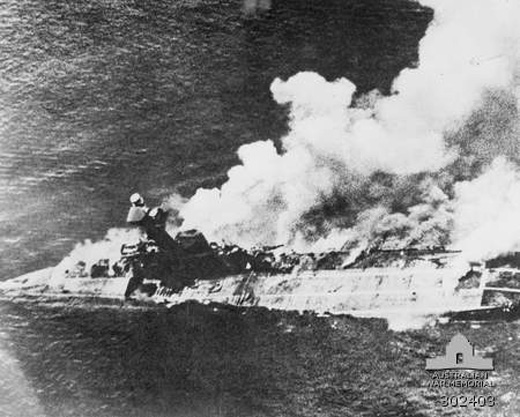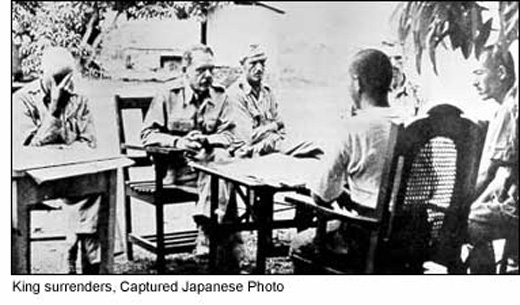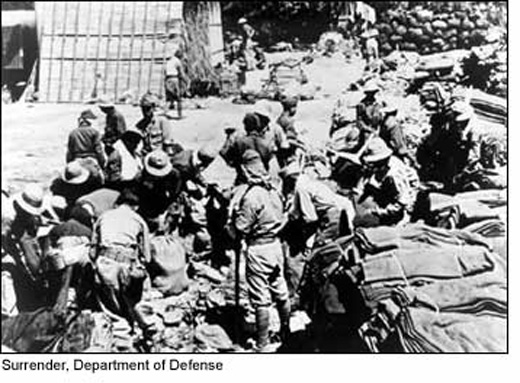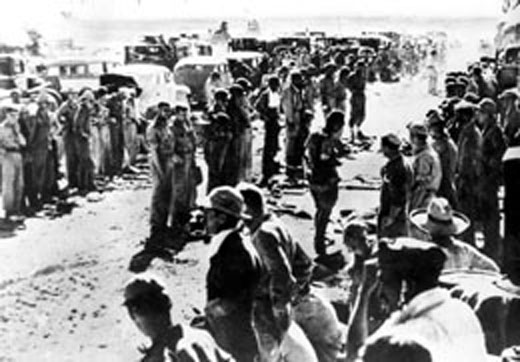Air Operations, Europe
BOMBER COMMAND7 Wellingtons are sent on cloud-cover raids to Essen. Only 1 plane bombs a village north of Essen. There are no losses.
[Battle of the Atlantic
- U-123 torpedoes the unarmed US freighter Esparta (3365t) about 14 miles south of Brunswick, Georgia. Only one of the 40-man crew is lost.
- The unarmed US freighter Malchace (3516t) is torpedoed and sunk by U-160 about 50 miles off Cape Hatteras, North Carolina. The Mexican freighter Faja de Oro rescues the 28 survivors. One crewman is lost.
- U-552 torpedoes and sinks the unarmed US tanker Atlas (7137t) off Cape Hatteras, North Carolina with the loss of two of the 34-man crew. The Coast Guard cutter CG-462 rescues the survivors. Later the same day, the US tanker Tamaulipas (6043t) is torpedoed by U-552. The British trawler HMS Norwich City rescues 35 survivors of the crew of 37.
Burma
The British troops take positions along a front of about 37 miles between Taungdwingyi and Minhla on the Irrawaddy, to defend the oil wells in the area. Both the Allies and the Japanese are preparing offensives, but the Japanese are ready first because they have been more quickly reinforced.
[Diplomatic Relations
Vichy France protests the establishment of an American consulate in Brazzaville in the French Congo.
[Eastern Front
German attempts to relieve the units of 16th Army trapped around Demyansk make some progress. In the Crimea, the Russians launch violent attacks but make virtually no progress.
Gen Mikhail G. Yefremov, commander of the Russian 33rd Army, commits suicide near Vyazma rather that surrender to the Germans. Yefremov was one of the heroes of the Red Army in the defense of Moscow.
SOUTHERN SECTORThe Soviets renew their offensive in the Crimea, attacking on the Kerch peninsula with 8 rifle divisions, supported by 150 tanks. Yet again the Soviets attack with waves of infantry. This attack is a prelude to the next phase of the Soviet offensive. The Red Army achieves little, however.
[Indian Ocean
Trincomalee, on the east coast of Ceylon, is attacked by planes from Nagumo's carriers destroying naval and airfield installations. At the same time a British carrier and a destroyer are reported 70 miles south of Batticaloa, also on the island's east coast. The small British carrier HMS Hermes, undefended, as its aircraft have taken off on an unsuccessful raid on the Japanese fleet is hit by 40 bombs. The Australian destroyer Vampire suffers 13 explosions. They both sink within about ten minutes. Almost 400 men are lost on the carrier, 9 on the destroyer. The British tanker Athelstane (5571t) is also sunk east of Ceylon. While rescuing survivors from the tanker, the British corvette Hollyhock is also sunk. 48 are lost on the corvette, 16 survivors are picked up by Athelstane's boat. The British Eastern Fleet retires to Bombay and Kilindini, Kenya.
At the same time another Japanese fleet of 6 heavy cruisers and the light carrier Ryujo under Vice-Adm Takeo Kurita enters the Bay of Bengal and sinks about 135,000 tons of shipping, almost all engaged in carrying troops and supplies to Burma. The two Japanese squadrons pass throught the Strait of Malacca and return to their bases unscathed.
In their operations in the Indian Ocean the Japanese forces have sunk 112,000 tons of merchant shipping along with one carrier, 2 cruisers and 4 smaller RN ships. This is the high-water mark of the of the Japanese carrier forces' success. Their limitations are now beginning to appear. It is notable that in the attacks on Colombo and Trincomalee, the efficiency of the Japanese strike has been sharply reduced by the small defense forces (even though these have been quickly overcome) when compared with the carriers' early successes.
Japanese Second Wave Attacks |
 |
Philippines
At 3:30a.m. Gen Edward P. King sends officers forward with a white flag to the Japanese forward positions to begin negotiations for surrencder. Unconditional surrender comes into effect at 12:30p.m. 76,000 men are captured, 12,000 of them American. Mopping-up operations follow along with the terrible march of the prisoners to San Fernando, 100 miles away. Thousands die because of ill-treatment along the way, which later becomes known as the 'march of death'. The surrender of Bataan is later approved by Roosevelt.[MORE]
Fighting continues in isolated areas of Luzon and the other islands with some US and Filipino units operating in a guerilla role. Japanese artillery sited at Cabcaben, on the south coast of the peninsula, opens fire on Corregidor, which has already been under attack from the air. Gen Wainwright holds out on Corregidor. The garrison of the island of Cebu is warned that a Japanese landing force is headed their way.
|
|
|
|
United States, Home Front
Gasoline deliveries to 17 states are cut back.
[


